Figures & data
Figure 1. An example of the Bayesian network structure. Variable A influences the likelihood of the LastJOA, which influences variables B and C. The conditional independence between nodes shows the probability that the expression of variables B and C is not influenced by variable A given the information for the LastJOA. LastJOA: last follow-up Japanese Orthopaedic Association score.
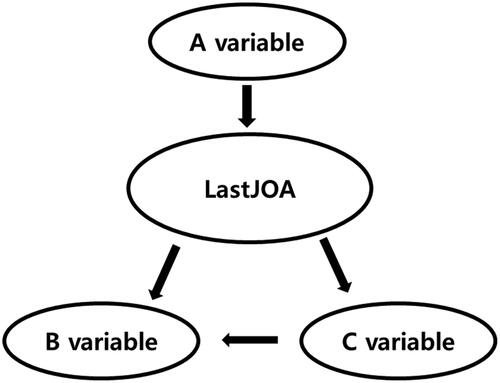
Table 1. Patient characteristics.
Table 2. Multiple linear regression analysis of three factors.
Figure 2. First and second Bayesian networks (BNs) relevant to the LastJOA. Panel A shows the first BN with 25 variables. Sex, dementia and PreJOA are the parent variables of the LastJOA, and the ASIA grade is only child variable of the LastJOA. Panel B shows that the second BN comprises 16 variables that are within the second-degree Markov blanket of the LastJOA variable in the first BN. In the second BN, the parent variables of LastJOA are sex, dementia and PreJOA, and the child variable is ASIA grade. The Bayesian network inference with Java Objects (BANJO) scores were –850.7081 and –564.9072 for the first and second BNs, respectively. ASIA: American Spinal Injury Association; BMI: body mass index; BN: Bayesian network; DM: diabetes mellitus; LastJOA: last follow-up Japanese Orthopaedic Association score; PreJOA: preoperative Japanese Orthopaedic Association score; OPLL: ossification of posterior longitudinal ligament.
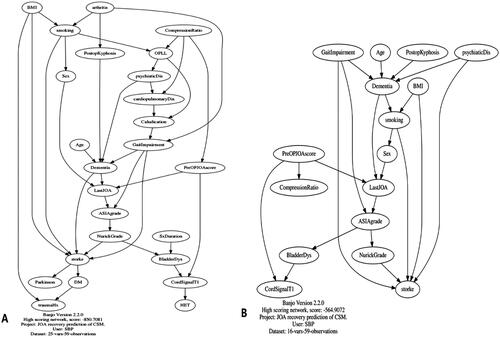
Figure 3. Bayesian network via Bayesian network inference with Java Objects (BANJO) analysis (A) and Order algorithm and structural code (B) with variables relevant to the LastJOA. The connection between variables and the direction of the arrow between them are similar in the two structures. The log-likelihood score in the Order algorithm and structure code was superior to that in the last BANJO analysis (–214.384 vs. –222.6719). ASIA: American Spinal Injury Association; LastJOA: last follow-up Japanese Orthopaedic Association score; PreJOA: preoperative Japanese Orthopaedic Association score.
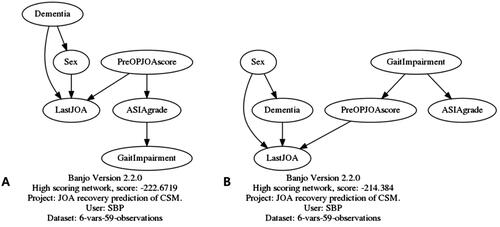
Figure 4. Final Bayesian network structure and different conditions for the LastJOA obtained using GeNIe. Panel A shows the Bayesian structure learned with the existing dataset using GeNIe. State 0 and 1 in the Gait_disturbance, dementia and sex nodes represent the probability of the occurrence of that comorbidity for the first two variables or male. States 0, 1 and 2 in the other nodes represent the discretized values of 0, 1 and 2, respectively. Panels B and C show that the change in the states in other variables after the LastJOA was conditioned as state 0 or 2. ASIA: American Spinal Injury Association; LastJOA: last follow-up Japanese Orthopaedic Association score; PreJOA: preoperative Japanese Orthopaedic Association score.
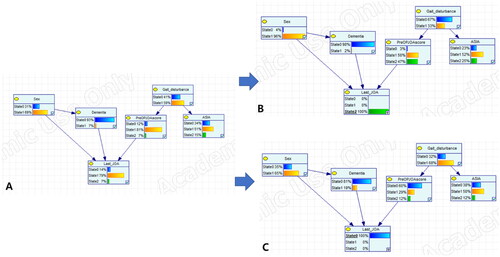
Figure 5. Bayesian network structures according to different conditions of sex and PreJOA. The figure shows the change in probability of the LastJOA in the different conditions according to the probabilities of sex (A, B) and the PreJOA (C, D). ASIA: American Spinal Injury Association; LastJOA: last follow-up Japanese Orthopaedic Association score; PreJOA: preoperative Japanese Orthopaedic Association score.
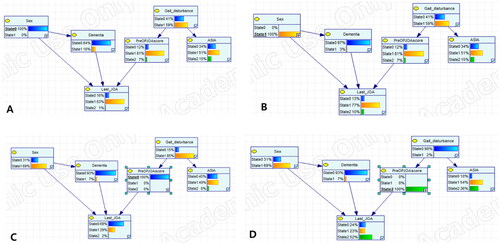
Figure 6. Bayesian network structures according to different conditions for the dementia node formation. Panels A and B show the change in probability of the LastJOA in the different conditions for the probability of dementia. Panels C and D show the change in probability for the LastJOA for the different conditions according to the probabilities of dementia and conditioned dementia, simultaneously. ASIA: American Spinal Injury Association; LastJOA: last follow-up Japanese Orthopaedic Association score; PreJOA: preoperative Japanese Orthopaedic Association score.
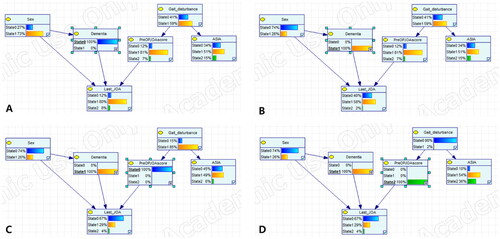
Figure 7. Bayesian network structures under different conditions of sex, dementia and PreJOA, simultaneously. The figure shows the best (A) and worst (B) combinations of parent nodes for the LastJOA node in the Bayesian network structures. ASIA: American Spinal Injury Association; LastJOA: last follow-up Japanese Orthopaedic Association score; PreJOA: preoperative Japanese Orthopaedic Association score.

Data availability statement
The authors of the included studies should be contacted individually regarding requests to share individual patient data.
